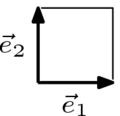The Geometric Interpretation of the Determinant
This parallelogram picture
is familiar from the construction of the sum of the two vectors. One way to compute the area that it encloses is to draw this rectangle and subtract the area of each subregion.
The fact that the area equals the value of the determinant
is no coincidence. Template:AnchorThe properties in the definition of determinants make reasonable postulates for a function that measures the size of the region enclosed by the vectors in the matrix.
For instance, this shows the effect of multiplying one of the box-defining vectors by a scalar (the scalar used is ).
The region formed by and is bigger, by a factor of , than the shaded region enclosed by and . That is, and in general we expect of the size measure that . Of course, this postulate is already familiar as one of the properties in the defintion of determinants.
Another property of determinants is that they are unaffected by pivoting. Here are before-pivoting and after-pivoting boxes (the scalar used is ).
Although the region on the right, the box formed by and , is more slanted than the shaded region, the two have the same base and the same height and hence the same area. This illustrates that . Generalized, , which is a restatement of the determinant postulate.
Of course, this picture
shows that , and we naturally extend that to any number of dimensions , which is a restatement of the property that the determinant of the identity matrix is one.
With that, because property (2) of determinants is redundant (as remarked right after the definition), we have that all of the properties of determinants are reasonable to expect of a function that gives the size of boxes. We can now cite the work done in the prior section to show that the determinant exists and is unique to be assured that these postulates are consistent and sufficient (we do not need any more postulates). That is, we've got an intuitive justification to interpret as the size of the box formed by the vectors. (Comment. An even more basic approach, which also leads to the definition below, is in Template:Harv.
The definition of volume gives a geometric interpretation to something in the space, boxes made from vectors. The next result relates the geometry to the functions that operate on spaces.
The two sentences state the same idea, first in map terms and then in matrix terms. Although we tend to prefer a map point of view, the second sentence, the matrix version, is more convienent for the proof and is also the way that we shall use this result later. (Alternate proofs are given as Problem 16 and Problem 21].)
Recall that determinants are not additive homomorphisms, need not equal . The above theorem says, in contrast, that determinants are multiplicative homomorphisms: does equal .
Resources
- Determinants as Size Functions, Wikibooks: Linear Algebra



























